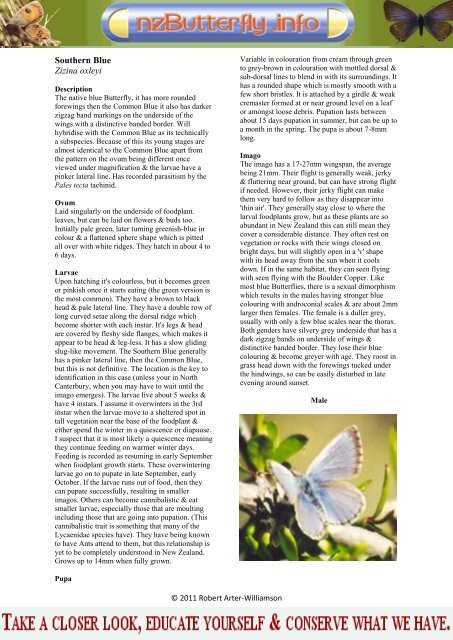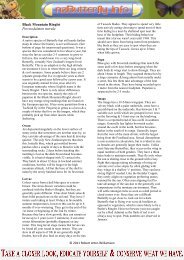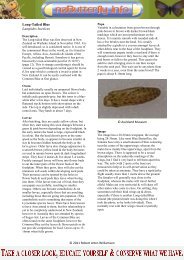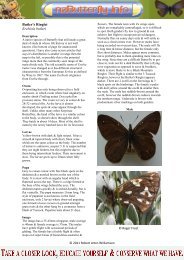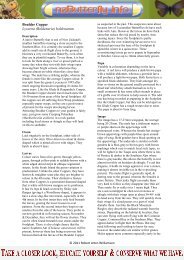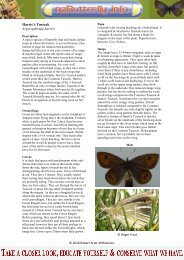Southern Blue Zizina oxleyi - NZ Butterfly Info
Southern Blue Zizina oxleyi - NZ Butterfly Info
Southern Blue Zizina oxleyi - NZ Butterfly Info
- No tags were found...
You also want an ePaper? Increase the reach of your titles
YUMPU automatically turns print PDFs into web optimized ePapers that Google loves.
<strong>Southern</strong> <strong>Blue</strong><strong>Zizina</strong> <strong>oxleyi</strong>DescriptionThe native blue <strong>Butterfly</strong>, it has more roundedforewings then the Common <strong>Blue</strong> it also has darkerzigzag band markings on the underside of thewings with a distinctive banded border. Willhybridise with the Common <strong>Blue</strong> as its technicallya subspecies. Because of this its young stages arealmost identical to the Common <strong>Blue</strong> apart fromthe pattern on the ovum being different onceviewed under magnification & the larvae have apinker lateral line. Has recorded parasitism by thePales tecta tachinid.OvumLaid singularly on the underside of foodplant.leaves, but can be laid on flowers & buds too.Initially pale green, later turning greenish-blue incolour & a flattened sphere shape which is pittedall over with white ridges. They hatch in about 4 to6 days.LarvaeUpon hatching it's colourless, but it becomes greenor pinkish once it starts eating (the green version isthe most common). They have a brown to blackhead & pale lateral line. They have a double row oflong curved setae along the dorsal ridge whichbecome shorter with each instar. It's legs & headare covered by fleshy side flanges, which makes itappear to be head & leg-less. It has a slow glidingslug-like movement. The <strong>Southern</strong> <strong>Blue</strong> generallyhas a pinker lateral line, then the Common <strong>Blue</strong>,but this is not definitive. The location is the key toidentification in this case (unless your in NorthCanterbury, when you may have to wait until theimago emerges). The larvae live about 5 weeks &have 4 instars. I assume it overwinters in the 3rdinstar when the larvae move to a sheltered spot intall vegetation near the base of the foodplant &either spend the winter in a quiescence or diapause.I suspect that it is most likely a quiescence meaningthey continue feeding on warmer winter days.Feeding is recorded as resuming in early Septemberwhen foodplant growth starts. These overwinteringlarvae go on to pupate in late September, earlyOctober. If the larvae runs out of food, then theycan pupate successfully, resulting in smallerimagos. Others can become cannibalistic & eatsmaller larvae, especially those that are moultingincluding those that are going into pupation. (Thiscannibalistic trait is something that many of theLycaenidae species have). They have being knownto have Ants attend to them, but this relationship isyet to be completely understood in New Zealand.Grows up to 14mm when fully grown.Variable in colouration from cream through greento grey-brown in colouration with mottled dorsal &sub-dorsal lines to blend in with its surroundings. Ithas a rounded shape which is mostly smooth with afew short bristles. It is attached by a girdle & weakcremaster formed at or near ground level on a leafor amongst loose debris. Pupation lasts betweenabout 15 days pupation in summer, but can be up toa month in the spring. The pupa is about 7-8mmlong.ImagoThe imago has a 17-27mm wingspan, the averagebeing 21mm. Their flight is generally weak, jerky& fluttering near ground, but can have strong flightif needed. However, their jerky flight can makethem very hard to follow as they disappear into'thin air'. They generally stay close to where thelarval foodplants grow, but as these plants are soabundant in New Zealand this can still mean theycover a considerable distance. They often rest onvegetation or rocks with their wings closed onbright days, but will slightly open in a 'v' shapewith its head away from the sun when it coolsdown. If in the same habitat, they can seen flyingwith seen flying with the Boulder Copper. Likemost blue Butterflies, there is a sexual dimorphismwhich results in the males having stronger bluecolouring with androconial scales & are about 2mmlarger then females. The female is a duller grey,usually with only a few blue scales near the thorax.Both genders have silvery grey underside that has adark zigzag bands on underside of wings &distinctive banded border. They lose their bluecolouring & become greyer with age. They roost ingrass head down with the forewings tucked underthe hindwings, so can be easily disturbed in lateevening around sunset.MalePupa© 2011 Robert Arter-Williamson
South Island & parts of the North Island as thereare 3 areas outside the 'normal' range of the<strong>Southern</strong> <strong>Blue</strong> (Central Plateau, Mount Robert &the Waiho Gorge) that they have being reported(none recently that I'm aware of).HabitatIt prefers areas that have a varied habitat thatincludes shelter, food including nectar plants &stones for sunbathing. This means it can be foundflying close to the ground over lawns, grasslands,roadsides & riverbeds up to 900m.FemaleFood PlantsNatives include low-growing brooms(Carmichaelia spp) & Scree Pea (Montigenanovae-zelandiae). But like the Common <strong>Blue</strong>, italso oviposits on low-growing plants from theFabaceae family like Pink Clover (Trifoliumpratense), White Clover (Trifolium repens), Hare'sFoot clover (Trifolium arvense), Toothed BurClover (Medicago polymorpha), Bird's-foot Trefoil(Lotus corniculatus), Greater Bird's-foot Trefoil(Lotus pedunculatus) & Tree Lucerne(Chamaecytisus palmensis).StatusCommon East of the southern alps from NorthCanterbury to North Southland. There is oddpopulations on the Central Plateau, Mount Robert& the Waiho Gorge, which could mean that the<strong>Southern</strong> <strong>Blue</strong> has lost territory to the Common<strong>Blue</strong> since native Tussock predominant grasslandshave being replaced with farm pasture.DistributionThere are rumours of hybridisation between theCommon & <strong>Southern</strong> <strong>Blue</strong> in North Canterbury &the Waiho Gorge, however out of the 3 studies thathave tackled the subject, 2 (Gibbs 1980 & Gillespie2010) suspect hybridisation does occur & 1 (Yagoet al. 2008) says there is no evidence ofhybridisation. Hybridisation in wild populationswill be up for discussion until such time a full studyis undertaken. I suspect that the Common <strong>Blue</strong> hasdisplaced the <strong>Southern</strong> <strong>Blue</strong> in the north of the© 2011 Robert Arter-Williamson
PhenologyThis is based on the Common <strong>Blue</strong>, so may havesome inaccuracies.CopyrightAll content belongs to Robert Arter-Williamsonand www.nzbutterfly.info.Factsheet Design lay out by Stuart Desjardins.© 2011 Robert Arter-Williamson


